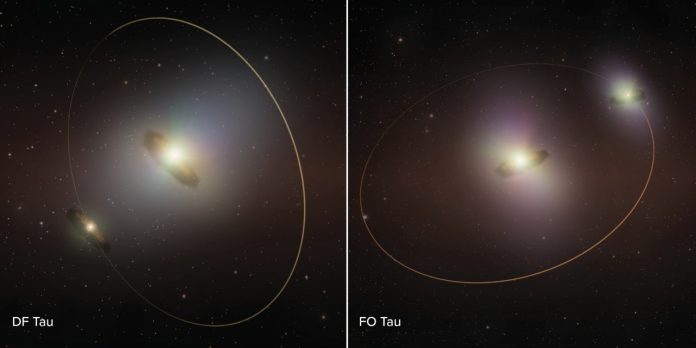
Over 5,000 exoplanets have been discovered around distant star systems.
Protoplanetary disks have been discovered too and it’s these, out of which all planetary systems form.
Such disks have recently been found in two binary star systems.
The stellar components in one have a separation of 14 astronomical units (the average distance between the Earth and Sun is one astronomical unit) and the other system has a separation of 22 astronomical units.
Studying systems like these allow us to see how the stars of a binary system interact and how they can distort protoplanetary disks.
The discovery of planetary systems around other stars has changed our view of the universe and how stellar systems evolve.
The first confirmed detection occurred in 1995 and since then, advanced telescopes and detection techniques have enabled the detection of thousands of exoplanets.
Space missions like Kepler and TESS have helped to categorise the planets and have identified large gas planets to Earth-sized rocky worlds, some in their star’s habitable zone.
Protoplanetary disks have also been studied and so our understanding of the formation of planetary systems has improved markedly since.
The disks of gas and dust around stars have been known to be the precursor to planetary systems for some years. What has been uncertain is the conditions that allow the disk to remain long enough for planets to form and what can lead to their early dissipation.
An announcement of protoplanetary disks around young binary stars was announced at a meeting of the American Astronomical Society by a team of researchers from National Radio Observatory.
They used the Atacama Large Millimetre/sub-millimetre Array otherwise known as ALMA and the near-infrared capability of the Keck II 10 metre telescope. ALMA has been setup in the Atacama Desert at an altitude of 5,000 metres so that the air is clear and dry.
It’s composed of 66 antennae all working together as an interferometer to study the coldest and most distant objects in the universe.
The disks around pre-main sequence binary stars as announced provides an excellent opportunity to study the disks and try to find answers to the questions.
The team explored the disk sizes, structure and inclination in relation to the star’s rotation speed and magnetic field strength to try and understand the complex processes at play.
Binary and multiple star systems like the DF Tau and FO Tau binary system that were the target of the study are common making an excellent case study.
DF Tau is a binary quasi-twin star system with component separation of 14 astronomical units with elongated orbits. ALMA detected two circumstellar cool dust disks with one locked magnetically to the star and accreting material onto it.
The inner disk seems to have largely eroded and decoupled from the rapidly rotating star.
This suggests a link between the rotation of the star, magnetic disk locking and the resultant early disk dissipation. Misalignment of the orbits and disks could impact the evolution of the disk. FO Tau is slightly different where the disks are aligned with the binary orbit, the stars have modest rotation speeds and seem to be magnetically locked to their disks.
ALMA has afforded high resolution images revealing fine levels of disk sub-structures which include spiral patterns, gaps and ring formations around single stars and wide binary companions.
It cannot yet resolve detail in the disks of DF Tau and FO Tau systems, to be able to determine disk properties in close binary systems marks a step forward in our understanding of planetary formation.
Written by Mark Thompson/Universe Today.



